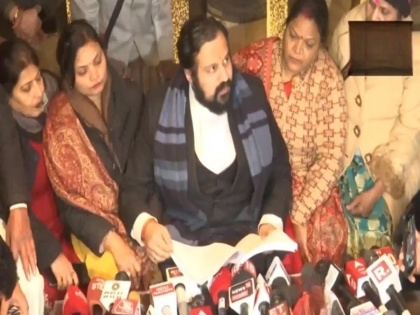‘There Existed Large Hindu Temple…’: Hindu Side Lawyer Cites ASI Report on Gyanvapi Complex Survey
By ANI | Published: January 25, 2024 10:35 PM2024-01-25T22:35:09+5:302024-01-25T22:35:15+5:30
A day after the Varanasi district court ruled that Archaeological Survey of India (ASI) survey report on the Gyanvapi ...

‘There Existed Large Hindu Temple…’: Hindu Side Lawyer Cites ASI Report on Gyanvapi Complex Survey
A day after the Varanasi district court ruled that Archaeological Survey of India (ASI) survey report on the Gyanvapi mosque complex will be given to litigants on both sides, advocate Vishnu Shankar Jain, the counsel for the Hindu side said that ASI has made a "conclusive finding" and said that there existed a large Hindu Temple prior to construction of the existing structure.
"The ASI has said that there existed a large Hindu Temple prior to the construction of the existing structure. This is the conclusive finding of the ASI," Vishnu Shankar Jain told the media here. He said the ASI has stated that during the survey, a number of inscriptions were noticed on the existing and pre-existing structure.
Varanasi, Uttar Pradesh | Advocate Vishnu Shankar Jain, representing the Hindu side, gives details on the Gyanvapi case.
— ANI (@ANI) January 25, 2024
He says, "The ASI has said that based on the scientific studies survey carried outstudy of architectural remains, exposed features and artefacts… https://t.co/fKsoyRViHVpic.twitter.com/LKscLiieX5
"A total of 34 inscriptions were recorded during the present survey and 32 stamped pages were taken. These are in fact inscriptions on the stone of a pre-existing Hindu temple which have been reused during the construction, repair of the existing structure. They include inscriptions in the Devanagari, Grantha, Telugu and Kannada scripts. The reuse of earlier inscriptions in the structure suggests that the earlier structures were destroyed and their parts were reused in the construction repair of the existing structure. Three names of deities such as Janardana, Rudra and Umeshwara are found in these inscriptions," the advocate said.
Giving more details, Vishnu Shankar Jain said the ASI has said that the pillars and plasters used in the existing structure were studied systematically and scientifically for the enlargement of the mosque and "constructing Sahan".
"Based on scientific studies/survey carried out study of architectural remains, exposed features and artefacts inscriptions, art and sculptures, it can be said that there existed a Hindu temple prior to the construction of the existing structure," says part of the ASI report. pic.twitter.com/biUEdxRtCp
— ANI (@ANI) January 25, 2024
"Parts of pre-existing temples, including pillars and plasters, were reused with little modifications. A minute study of pillars and plasters in corridors suggests that they were originally part of a pre-existing Hindu temple for their reuse in the existing structure, Vyala figures carved on either side of the lotus medallion were mutilated and after removing the stone mass from the corners, that space was decorated with floral design. This observation is supported by two similar plasters still existing on the north and southern walls of the western chamber in their original place..."
The ASI carried out a survey of the Gyanvapi premises on court directions to determine if the mosque was constructed over a pre-existing structure of a Hindu temple. The ASI had submitted its survey report to the district court in a sealed cover last month.
Open in app